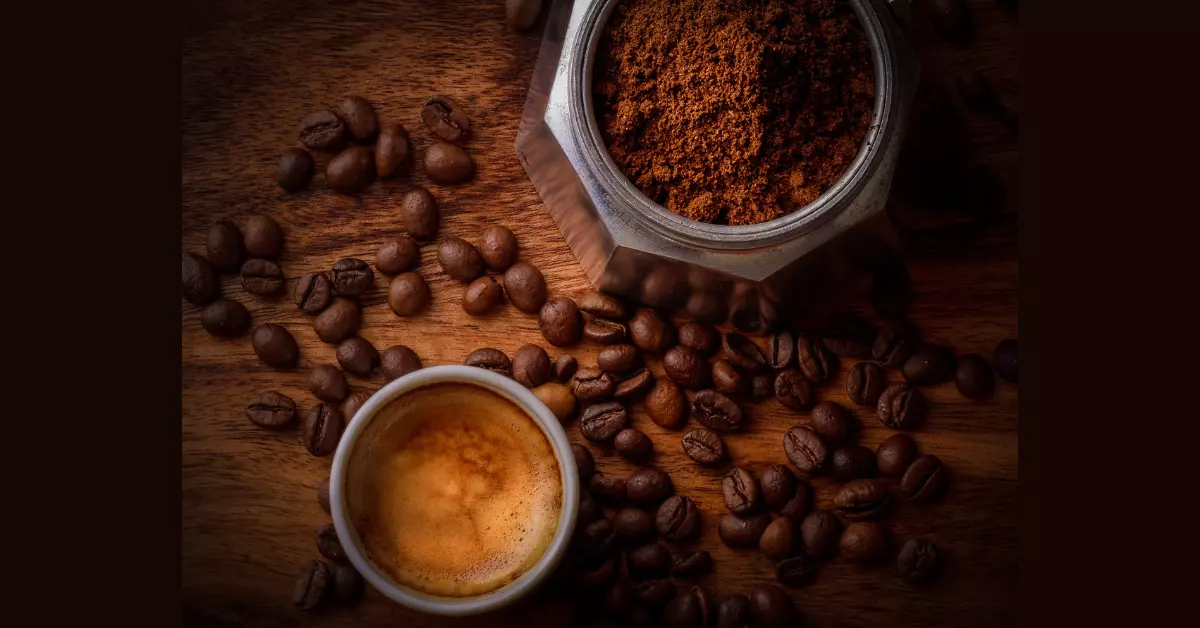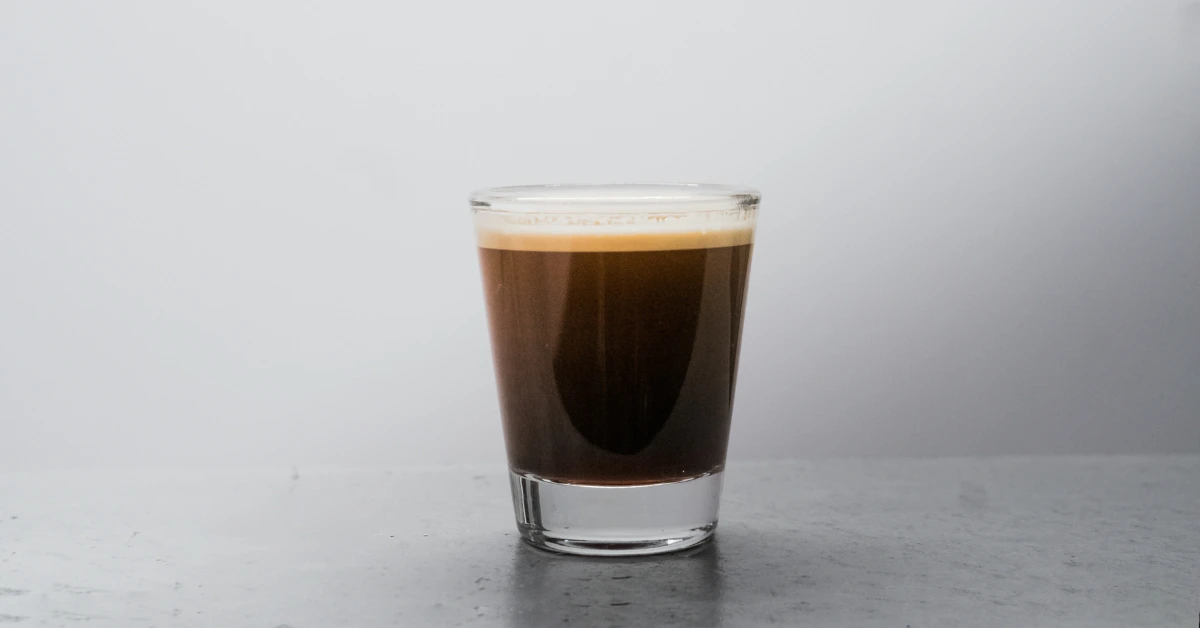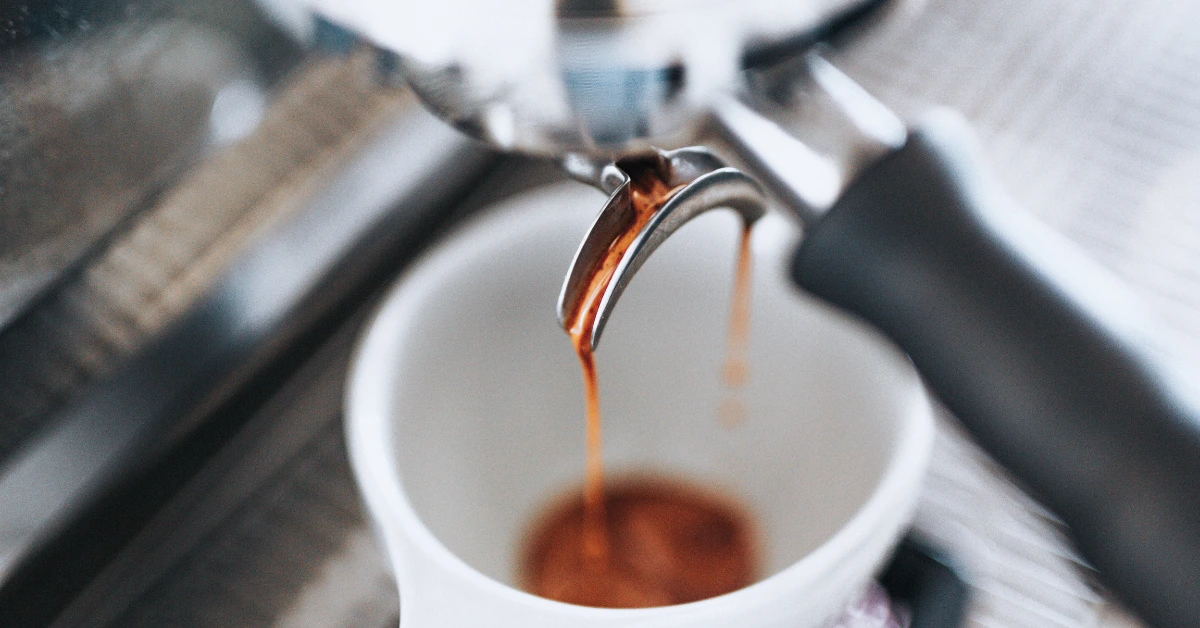
We all are familiar with Espresso more or less. Espresso is a strong and concentrated coffee. It has a rich and bold flavor. You might have used Espresso as the base of other coffees like Latte, Cappuccino, Americano etc. But do you know how to make Espresso? How much caffeine is in Espresso? If you use 4 shots of Espresso, you might think how much caffeine is in 4 shots of Espresso? To let you know everything about Espresso, here’s a proper guide to Espresso 101.
Using an Espresso machine, you can force hot water through finely-ground coffee beans to make Espresso. It takes only 25 to 30 seconds to make this. It is served in small portions but has a rich flavor. The amount of caffeine in espresso can differ based on factors like the size of the shot, the type of coffee used, and how it is made. On average, one shot of espresso (about 1 ounce or 30 millilitres) contains around 63 milligrams of caffeine. So, if you have four shots of espresso, the total caffeine content would be around 252 milligrams. Remember that espresso has more caffeine per ounce compared to regular coffee.
Espresso And Its Machines
Let’s discuss what Espresso is and what type of machines are used to make it.

Espresso is a strong and flavorful coffee drink. This drink originated in Italy. Usually, people make this beverage by forcing hot water through coffee beans using high pressure. It creates a concentrated shot of coffee with a foamy layer on top. Espresso is served in small cups and can be enjoyed on its own. You can also use it for other coffee bases. It has a strong taste and more caffeine than regular coffee. Espresso machines are commonly used to make it.
Espresso Machines
There are different types of Espresso machines. They include Manual, Semi-Automatic, Fully Automatic, Super-Automatic Espresso Machines etc. Here’s a brief description of them.

|
Espresso Machines |
Description |
| Manual Espresso Machine | In this machine, you will have full control over the water flow and pressure during extraction. It requires practice and skill. |
| Semi-Automatic Espresso Machine | The machine automates the entire brewing process, including water temperature, pump pressure, and brew time. It’s user-friendly and delivers consistent results. |
| Fully Automatic Espresso Machine | This type of machine has a built-in grinder. It can perform all tasks from grinding the beans to brewing the espresso with the press of a button. It’s very convenient but sacrifices some control. |
| Super-Automatic Espresso Machine | These are similar to a Semi-automatic machine, but it also include a doser to measure and dispense the coffee grounds. |
| Pod Espresso Machine | These machines use pre-packaged coffee pods or capsules. You simply insert the pod, and the machine does the rest. It offers simplicity and convenience but limits customization options. |
| Commercial Espresso Machine | These machines are designed for high-volume use. These have multiple group heads for simultaneous brewing. They are durable and often have additional features like steam wands for milk frothing. |
| Semi-Automatic with Doser | These are similar to a Semi-automatic machine, but they also include a doser to measure and dispense the coffee grounds. |
| Fully Automatic with Doser | Like the Automatic machine, but with a doser. It takes care of the brewing process automatically. |
| Pump Espresso Machine | These machines use a pump to create the necessary pressure for extraction. They are versatile and commonly used for home brewing. |
| Steam Espresso Machine | This type of machine uses steam to create pressure for extraction. It is simple to use but may not produce the same quality as machines with pumps. |
| Thermoblock Espresso Machine | These machines use a thermoblock to control the water temperature during extraction. They heat water quickly, making them efficient for single servings. |
| Dual Boiler Espresso Machine | It has two separate boilers, one for brewing and one for producing steam. This machine allows for simultaneous brewing and milk frothing. It offers precise temperature control. |
| Heat Exchange Espresso Machine | These machines use a single boiler with a heat exchanger to brew espresso and produce steam simultaneously. They are efficient and deliver consistent results. |
Useful Parts of Espresso Machine
For a better understanding, here is some information about important parts of an Espresso machine.
Portafilter: The handle-like device that holds the coffee grounds for brewing Espresso.
Group Head: The part where the portafilter attaches. It is responsible for delivering hot water and extracting Espresso.
Boiler: The component that heats and maintains the water temperature for brewing.
Steam Wand: The tool used to steam and froth milk for drinks like lattes and cappuccinos.
Water Reservoir: The removable container that holds the water used for brewing.
Pump: The mechanism that creates the necessary pressure to force water through the coffee grounds.
Control Panel: The panel with buttons and dials to control the machine’s functions and settings.
Drip Tray: The tray below the group head collects any excess water or coffee during brewing.
Understanding these parts is important for you to operate and maintain an Espresso machine effectively.
How to Make Espresso?
To make a perfect cup of Espresso, choose your Espresso machine well and just follow the steps. You will get your Espresso ready.
- Grind your coffee beans finely.
- Fill your Espresso machine’s water reservoir with clean, filtered water.
- Preheat your espresso machine as instructed.
- Clean the portafilter of your machine before using it. Distribute the coffee grounds evenly into the portafilter. Here you can use around 18 to 20 grams of coffee.
- Use a tamper to firmly press down the coffee grounds and create a level surface. Then, put the portafilter back into the machine and start brewing.
- Pay attention to the extraction time. It should be around 25 to 30 seconds.
- Once the extraction is complete, you’ll have a cup of rich Espresso ready to enjoy.
Remember, making good Espresso needs practice and experimentation. Adjust the process according to your taste and desire to get your Espresso.
Caffeine in Espresso
Espresso has more caffeine than any other coffee. Depending on some factors, the exact amount of caffeine can vary. These factors include the type of coffee beans used, the brewing method, the size of the shot and how it is made. Espresso shots are often served in larger sizes, such as double shots or in drinks like lattes. It means they will have higher caffeine levels. It is important to be aware of your caffeine sensitivity, as some people are more affected by caffeine than others.

How Much Caffeine is in 1 Shot of Espresso?
Though the amount varies according to some factors, we are giving the approximate amount. A single shot of Espresso is generally about 1 ounce or 30 mL (millilitres). It contains an average of 63 mg (milligrams) of caffeine. This amount of caffeine is much more than other coffees.
How Much Caffeine is in 4 (Four) Shots of Espresso?
As discussed previously, one shot of Espresso has around 63 milligrams (mg) of caffeine. So, four shots of Espresso would contain approximately 252 milligrams (mg) of caffeine in total. Remember that individual tolerance to caffeine can vary.
6 Benefits of Espresso
Espresso offers several benefits to coffee lovers. These benefits made it a popular choice. You might wonder what are the benefits. Here are some of the benefits of Espresso.

1. Strong and Concentrated Flavor
Espresso is well-known for its intense and bold taste. The way it is brewed extracts the rich oils and flavors from the coffee beans. That’s why you get a solid and flavorful cup of coffee. This concentrated brewing method ensures a robust and satisfying flavor experience.
2. Quick Preparation
Espresso is made quickly compared to other brewing methods. The entire brewing process usually lasts around 25 to 30 seconds. It is perfect for those who want their coffee promptly. This swift preparation can make Espresso a great choice when you’re in a hurry.
3. Higher Caffeine Content
Espresso typically has more caffeine than other coffee drinks. This is because of its smaller serving size and the way it is extracted. It leads to a higher concentration of caffeine per ounce or millilitres. So, if you’re looking for a stronger caffeine boost, Espresso is a good choice.
4. Versatility in Drink Options
Espresso is incredibly versatile and serves as the starting point for many coffee beverages. It acts as the foundation for drinks like cappuccinos, lattes, macchiatos, and Americanos. This versatility allows for a wide range of flavors and customization choices.
5. Crema
When Espresso is brewed, it creates a layer of crema on top. Crema is a creamy and caramel-colored foam. This adds a visually pleasing touch to the coffee. This makes the Espresso look even more appealing. It improves both the appearance and taste of the Espresso.
6. Aromatic Experience
When Espresso is brewed, it releases aromatic compounds. It creates a delightful and pleasing scent. This enticing aroma adds to the overall enjoyment of drinking Espresso. It makes the experience even more pleasurable for coffee lovers.
6 Harmful Effects of Espresso
1. High Caffeine
Espresso has more caffeine than regular coffee. So, if you are sensitive to caffeine, it can affect you. It can cause issues like increased heart rate, anxiety, insomnia, and digestive problems. Thus, avoid excessive consumption of Espresso if you are sensitive to caffeine.
2. Dependency Risk
Regular Espresso consumption can lead to dependence. You might end up requiring more caffeine for the same effects. In such cases, quitting abruptly can cause headaches and irritability.
3. Sleep Disruption
Drinking Espresso before bedtime or in large amounts can disturb sleep patterns. You might experience insufficient rest and daytime tiredness.
4. Digestive Problems
The acidity of Espresso may cause indigestion or stomach irritation in some individuals. If you intake too much Espresso, it can contribute to dehydration.
5. Sensitivity and Reactions
People with heart conditions, anxiety disorders, high blood pressure, or other issues may be more sensitive to Espresso. They may experience adverse reactions to Espresso.
6. Tooth Staining and Decay
The dark color and acidity of Espresso can stain your teeth over time. Sweetened or flavored Espresso drinks can also contribute to tooth decay. So, maintain oral hygiene if you are an Espresso lover.
Is There Any Coffee Shop Named “Espresso 101”?
There is a coffee shop named “Espresso 101”. It is situated in downtown Waldport, Oregon, US. This coffee shop offers different coffees. You can check it out if you are looking for this coffee shop. Other than this, it is possible to find a coffee shop named “Espresso 10”. Any local area or unpopular city can have a coffee shop of this name.
Comparison Among Espresso and Other Coffees
Let’s illustrate a table to compare Espresso along with other popular coffees.
|
Espresso |
Latte |
Cappuccino |
Americano |
Macchiato |
|
| Description | Espresso diluted with hot water, Similar flavor to regular coffee | Espresso combined with both steamed and foam milk | Strong and concentrated coffee shot, Extracted under high pressure | Equal parts espresso, Steamed milk, and milk foam | Stained Espresso, With a small amount of milk, Steamed or foam |
| Coffee to milk ratio | Predominantly coffee with minimal milk or foam | More milk than coffee, with a higher ratio of steamed milk to foam | A small amount of milk or foam provides a lighter texture | Equal parts coffee and hot water, little to no milk | A small amount of milk or foam is added to Espresso |
| Serving size | Typically served as a 1-ounce shot | Served in various sizes, ranging from 8 to 16 ounces | Served in various sizes, ranging from 8 to 12 ounces | Served in various sizes, ranging from 8 to 16 ounces | Served in a small size, usually around 2 to 4 ounces |
| Strength | Strong and concentrated coffee flavor | Mild coffee flavor with a creamy texture | Balanced coffee flavor with a velvety texture | Strong coffee flavor, similar to Espresso | Strong coffee flavor with a hint of milk |
| Milk Texture | Little to no milk or foam present | Creamy and velvety texture from steamed milk | Creamy texture with a balance of steamed milk and foam | No or minimal milk, resulting in a lighter texture | A small amount of milk or foam provides a lighter texture |
| Layering | No layering, only a shot of Espresso | No distinct layering; milk is integrated with Espresso | The distinct layering of Espresso, steamed milk, and milk foam | No layering; Espresso and hot water are mixed | No distinct layering; milk is added to Espresso |
Conclusion
In summary, Espresso is a strong and concentrated coffee with a rich flavor. Now you know the whole guideline as “Espresso 101”. It requires a special machine and we have discussed them. So, grab your favorite machine and follow the steps of “How to make Espresso?”. Before you enjoy Espresso, be cautious about the caffeine in Espresso. How much caffeine is in 1 or 4 shots of Espresso, we have already discussed this. So, take care of your health before enjoying your beverage. Moderate consumption is always good for your caffeine sensitivity and possible health effects. However, Espresso can be a delightful and energizing part of your coffee experience.

I am Mojoon, a certified and award-winning barista by choice, with 7 years of experience in the field. I have served and trained coffee shop baristas worldwide. I worked at Krispy Kreme for an extended period, and now I aim to help regular people brew coffee like me. I pursue this job with my passion for writing and also provide one-on-one coaching for newly minted baristas.